The Smolov squat program is a high-volume, high-frequency specialization routine intended to boost your squat as fast as possible.
It’s also considered one of the most difficult programs you can follow, which is why it’s often held up as a rite of passage for the hardiest and most dedicated.
Is this reputation warranted, though?
Does Smolov work as promised, or is it just a vain and masochistic way to win bragging rights and likes?
In this article, you’ll learn what the Smolov program is, who should attempt it and who shouldn’t, what the program entails, and more.
Table of Contents
+
What Is the Smolov Squat Program?
The Smolov Squat Program, often shortened to “Smolov,” is a 13-week weightlifting program designed to increase your squat strength.
It was named after its creator and “Russian Master of Sport,” Sergey Smolov, who reportedly used its principles to train the dominant Russian weightlifters of the mid-to-late twentieth century.
Smolov has been a mainstay in soviet weightlifting circles since the 70s, but it didn’t gain international notoriety until 2001. That’s when former Soviet Special Forces physical training instructor and leading fitness figure, Pavel Tsatsouline, wrote about it in the now defunct Powerlifting USA magazine.
Since then, it’s become infamous for its brutal high-frequency, high-intensity approach that promises to add up to 100 pounds to your squat one-rep max in just 3 months.
Who Is the Smolov Squat Program For?
Before we talk about who Smolov is for, let’s be clear about who Smolov most definitely isn’t for.
If . . .
- You’ve been weightlifting for less than ~3 years
- Your squat strength is regularly progressing on a different program
- You can’t train 4 days per week
- You’re cutting
- Your recovery and sleep are compromised (you work shifts or you’re a new parent, for example)
- Your goal is to build whole-body muscle, not just increase your squat
. . . Smolov isn’t for you.
If, however, you’re an advanced squatter whose progress has slowed to a crawl or stalled, and you’re on top of your diet, recovery, and sleep, Smolov might be worth a shot.
Bear in mind, though, that the Smolov program is grueling. Many who attempt it quit early because of exhaustion or injury. Don’t begin if you aren’t all in.
For these reasons, it’s generally used periodically to boost your squat—maybe once per year or even less often—not as a long-term “lifestyle” training program like Bigger Leaner Stronger or Thinner Leaner Stronger.
How Does the Smolov Squat Program Work?
The Smolov squat program is 13 weeks long and split into the following 5 phases: phase in, base cycle, switching phase, intense cycle, and taper week.
The program outlines precisely how much weight you should lift in every set based on a percentage of either your . . .
- One-rep max, which is the maximum amount of weight you can lift for a single repetition through a full range of motion with proper technique, or . . .
- Your training max, which is a percentage (usually 90%) of your one-rep max
In other words, your training max is a conservative one-rep max.
Traditionally, people used their one-rep max to calculate their “working weights” on Smolov. However, this approach has fallen out of favor in recent years because it’s particularly (and unnecessarily) demanding.
Using your training max is more sensible because it ensures you can complete all the prescribed sets and reps in each workout without wearing yourself to a frazzle and risking injury.
For Smolov, I recommend you use a training max equal to 90% of your one rep max, which you can calculate by multiplying your one-rep max by 0.9.
For example, if your squat one-rep max is 400 pounds, your training max would be 360 pounds.
Thus, if the program calls for you to lift 80% of your training max, you should load the bar with 288 pounds (80% of 360).
Phase In
The “phasing in” weeks ready your body for the rigors of squatting heavy 3-to-4 days per week.
The workouts should feel relatively easy. If they don’t, you may have calculated your training max incorrectly, so go back and check your math.
Here are the workouts. Again, all the percentages are based on your training max:
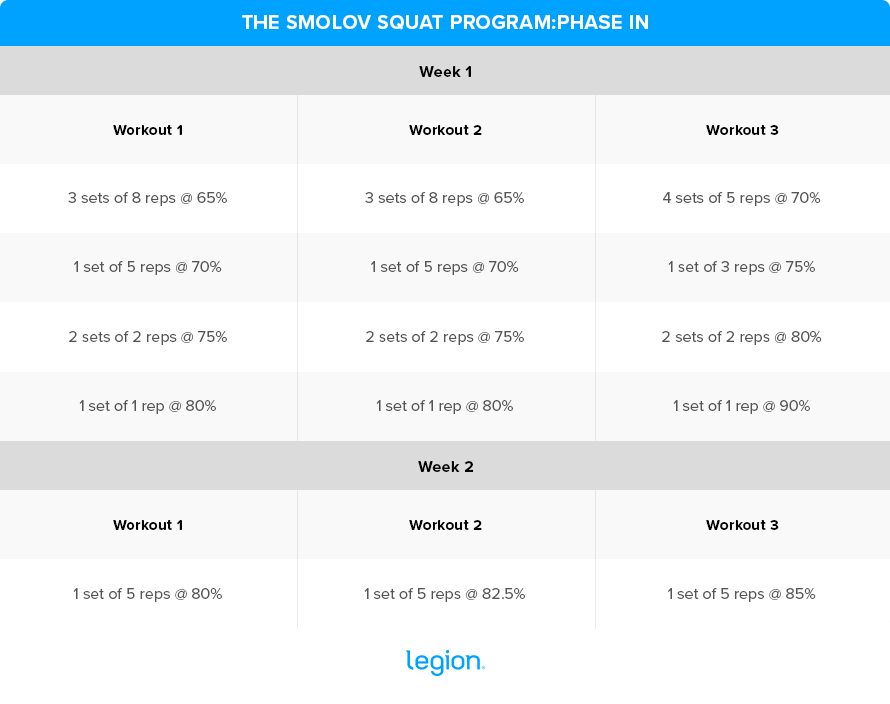
Base Cycle
The base cycle is the most grueling part of Smolov because it combines high frequency with high volume and intensity. During weeks 3-to-6 of the base cycle, you squat 4 times per week, and in the final week, you squat twice.
As you move through the base cycle, you get opportunities to increase the weight that you lift. The program recommends increasing the weight by 20 pounds in the second week of the base cycle (week 4 of the program) and an extra 10 pounds during the third week of the base cycle (week 5 of the program).
These increases aren’t cast-iron, though.
For example, if you fail to complete the prescribed sets and reps in the first week of the base cycle, stay at the same weight in the second week. Or, if you find it very challenging but just about doable, a 10-pound increase between weeks 1 and 2 of the base cycle is probably more fitting.
Likewise, only add an additional 10 pounds in the third week of the base cycle if you can do so and still complete your workouts.
In the final week of the base cycle, you do just two workouts. There are no set and rep targets in these workouts—instead, you use them to determine your new squat one-rep max.
To do this, complete a thorough warm-up, then load the bar with your current training max and perform one set of one rep of the squat. Rest for 3-to-5 minutes, then add 10-to-20 pounds to the bar (or a smaller increase if your first set was very difficult), and do another set of 1 rep. Continue this process of adding weight, performing one rep, and resting 3-to-5 minutes until you reach your limit.
The highest weight that you can lift for a single rep with good form through a full range of motion is your new one-rep max.
Here’s how the workouts look. Again, all the percentages are based on your training max, not your one-rep max:
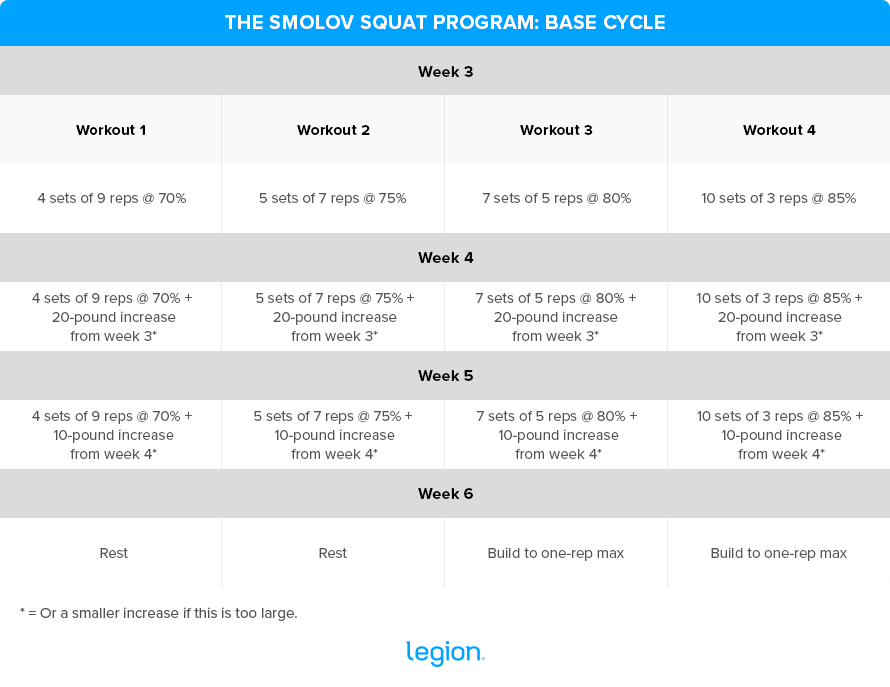
Switching Phase
The switching phase is a 2-week deload that gives you a rest from heavy squatting.
The program doesn’t prescribe specific workouts during the switching phase. Instead, it recommends that you use the time to focus on developing speed and power.
Thus, if you want to train during the switching phase, here’s what I recommend:
- Do 2-to-3 workouts per week.
- Do 3-to-5 sets of one lower-body exercise per workout.
- Do 5 reps per set.
- Use exercises that develop lower-body power, such as the power clean, jump squat, and paused back squat.
- Never lift more than 70% of your training max.
- Complete each rep as explosively as possible (while maintaining good form).
Intense Cycle
During the 4-week intense cycle, volume and frequency decrease to allow for higher training intensity. In other words, you do fewer workouts, sets, and reps per week, which allows you to lift heavier weights.
To calculate your weights for the intense cycle, take your new one-rep max (that you determined in the final week of the base cycle) and multiply it by 0.9 to get your new training max, then calculate all your training weights as a percentage of your training max.
For example, if your new one-rep max is 450 pounds, your new training max would be 405 pounds.
Thus, if the program calls for you to lift 90% of your training max, you should load the bar with 365 pounds.
Here are the workouts. As before, all the percentage are based on your training max:
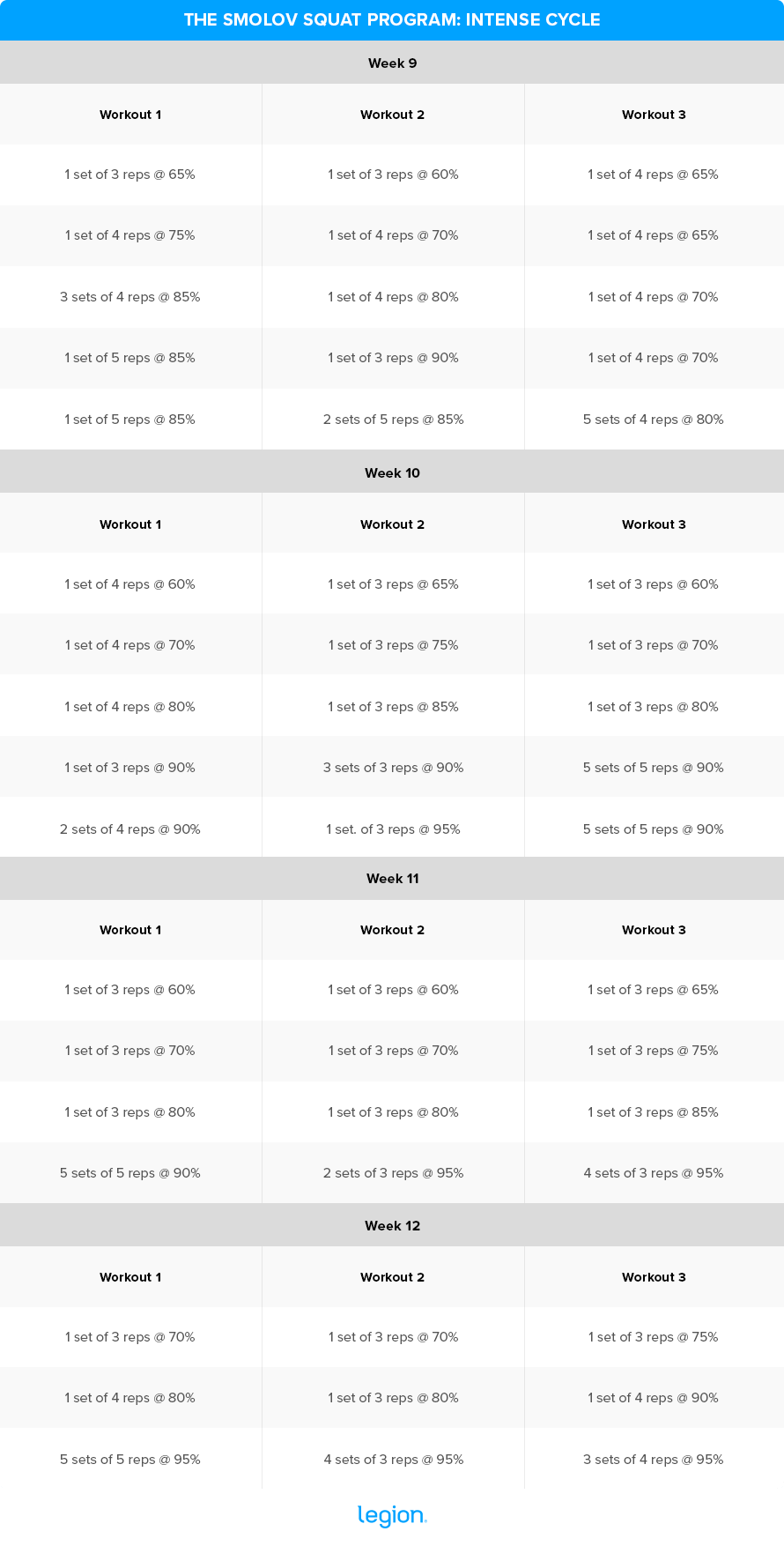
Taper Week
The taper week is the final week of the Smolov program. It involves two relatively low-volume workouts, then one final chance to test your one-rep max.
Here are the workouts. As always, base the percentages on your training max:
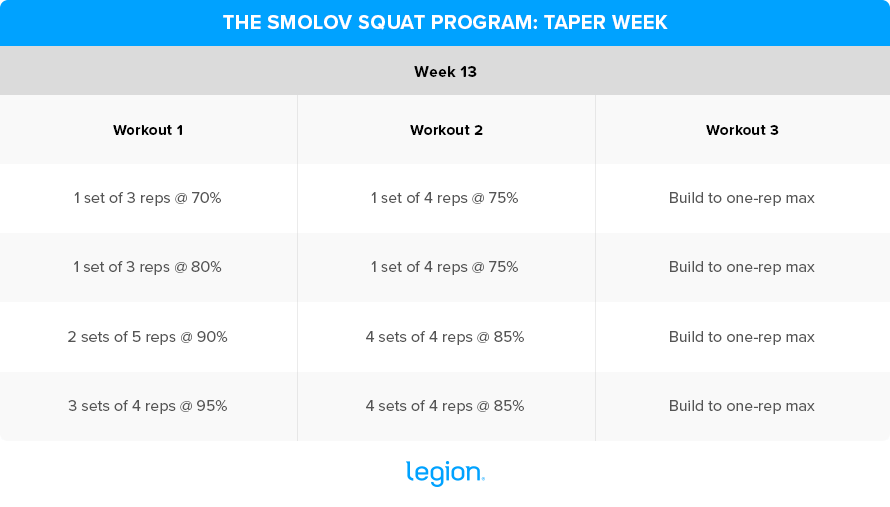
FAQ 1: Does the Smolov squat program help you build muscle?
Yes.
The Smolov program encourages you to progressively overload your muscles by lifting heavier weights over time, which is the number-one driver of muscle growth.
That said, Smolov isn’t the best training program for people whose primary goal is gaining muscle, especially not if you want to build full-body muscle. For that, you’ll need a more balanced program with a better mix of volume, intensity, and frequency and more exercise variety, such as my programs for men and women, Bigger Leaner Stronger and Thinner Leaner Stronger.
(Or if you aren’t sure if Bigger Leaner Stronger and Thinner Leaner Stronger are right for you or if another strength training program might be a better fit for your circumstances and goals, then take Legion Strength Training Quiz, and in less than a minute, you’ll know the perfect strength training program for you. Click here to check it out.)
FAQ 2: How much does Smolov add to your squat?
It varies greatly between weightlifters, but most people can expect to add between 40 and 100 pounds to their squat one-rep max in a single cycle assuming you optimize your diet and recovery during the program. Like any program, you can expect decreasing returns from Smolov as you get stronger and stronger and inch toward your genetic potential for strength and muscle gain.
FAQ 3: What is Smolov Jr.?
Smolov Jr. is a variation of the Smolov program modeled on the full version’s base cycle. It’s popular because it yields similar results to its bigger brother, but it’s shorter and less demanding, making it more doable for most weightlifters.
FAQ 4: Should you do other exercises on the Smolov program?
Most Smolov squat program guides recommend that you stick exclusively to the squat during the program and leave any other exercises for after you finish. You literally just squat.
While this works well, many people like to add “accessory” work to ensure they don’t lose muscle in areas of the body that aren’t trained by the squat, such as the upper back, chest, shoulders, and arms.
If this is the case for you, the trick is to . . .
- Do as little extra accessory exercise volume as possible to maintain your size and strength.
- Do one accessory exercise per workout after you’ve finished your Smolov training. That’s all it takes to keep your other body parts from getting smaller and weaker.
With that in mind, here’s what I recommend:
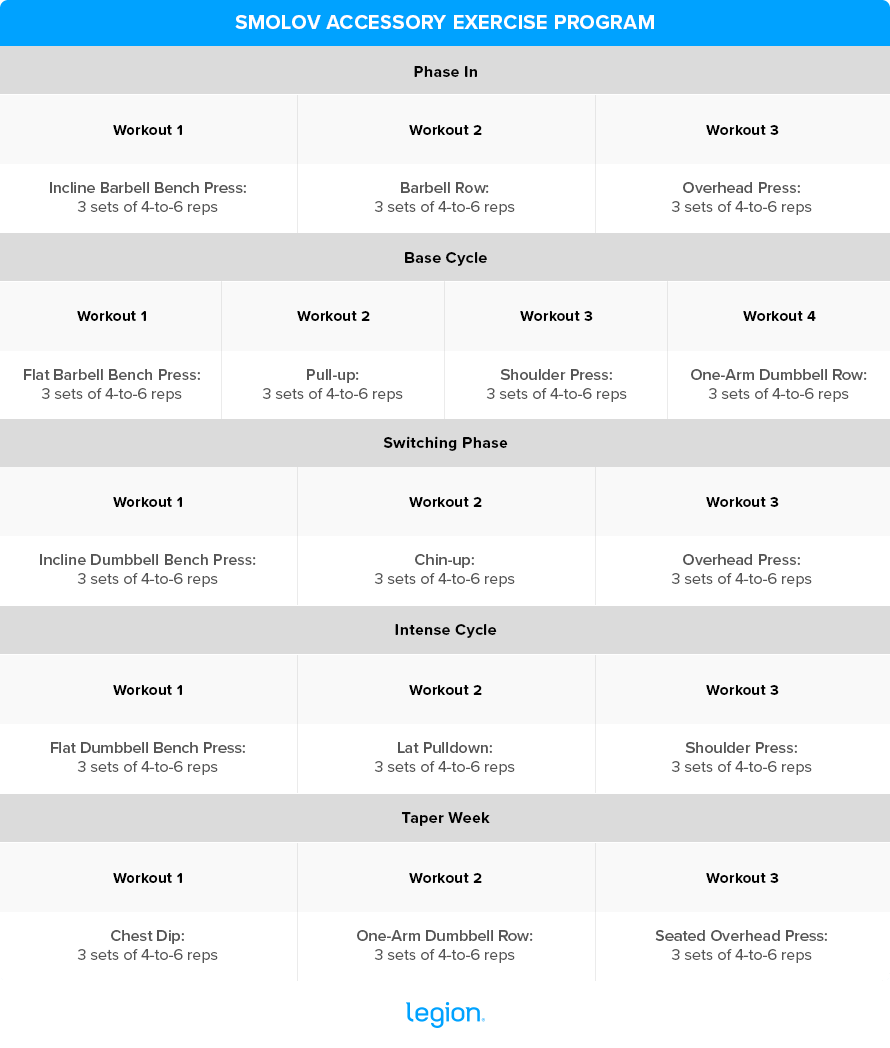
FAQ 5: Which supplements should I take during Smolov?
You don’t need to take any supplements during Smolov, but the right ones can help.
The best supplements for boosting your performance and recovery while you complete the Smolov squat program are:
- 0.8-to-1.2 grams of protein per pound of body weight per day. This provides your body with the “building blocks” it needs to build and repair muscle tissue and help you recover from your workouts. If you want a clean, convenient, and delicious source of protein, try Whey+ or Casein+.
- 3-to-5 grams of creatine per day. This will boost muscle and strength gain, improve anaerobic endurance, and reduce muscle damage and soreness from your pull workouts. If you want a 100% natural source of creatine that also includes two other ingredients that will help boost muscle growth and improve recovery, try Recharge.
- One serving of Pulse per day. Pulse is a 100% natural pre-workout drink that enhances energy, mood, and focus; increases strength and endurance; and reduces fatigue. You can also get Pulse with caffeine or without.
(And if you’d like even more specific advice about which supplements you should take to reach your health and fitness goals, take the Legion Supplement Finder Quiz, and in less than a minute, you’ll know exactly what supplements are right for you. Click here to check it out.)
FAQ 6: What is a Smolov calculator?
You have to do a fair amount of number crunching to calculate your training weights on Smolov. If math isn’t your forte, this can be more daunting than the squatting.
A Smolov calculator is an online calculator that does all of the math for you. All you have to do is plug in your one-rep max and it tells you how much weight you need to lift in every set of the program.
Scientific References +
- Schoenfeld, B. J. (2010). The mechanisms of muscle hypertrophy and their application to resistance training. Journal of Strength and Conditioning Research, 24(10), 2857–2872. https://doi.org/10.1519/JSC.0B013E3181E840F3
- Stokes, T., Hector, A. J., Morton, R. W., McGlory, C., & Phillips, S. M. (2018). Recent Perspectives Regarding the Role of Dietary Protein for the Promotion of Muscle Hypertrophy with Resistance Exercise Training. Nutrients, 10(2). https://doi.org/10.3390/NU10020180
- Branch, J. D. (2003). Effect of creatine supplementation on body composition and performance: a meta-analysis. International Journal of Sport Nutrition and Exercise Metabolism, 13(2), 198–226. https://doi.org/10.1123/IJSNEM.13.2.198
- Eckerson, J. M., Stout, J. R., Moore, G. A., Stone, N. J., Iwan, K. A., Gebauer, A. N., & Ginsberg, R. (2005). Effect of creatine phosphate supplementation on anaerobic working capacity and body weight after two and six days of loading in men and women. Journal of Strength and Conditioning Research, 19(4), 756–763. https://doi.org/10.1519/R-16924.1
- Bassit, R. A., Pinheiro, C. H. D. J., Vitzel, K. F., Sproesser, A. J., Silveira, L. R., & Curi, R. (2010). Effect of short-term creatine supplementation on markers of skeletal muscle damage after strenuous contractile activity. European Journal of Applied Physiology, 108(5), 945–955. https://doi.org/10.1007/S00421-009-1305-1










